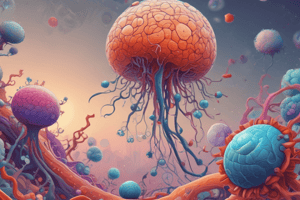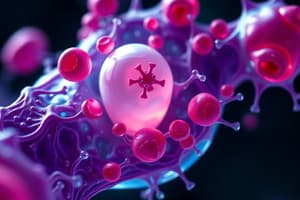Podcast
Questions and Answers
What is the fundamental unit of life?
What is the fundamental unit of life?
- Cell (correct)
- Tissue
- Organ
- Organism
Which statement accurately reflects the Classical Cell Theory?
Which statement accurately reflects the Classical Cell Theory?
- Cells are the basic unit of life. (correct)
- All living organisms are unicellular.
- Cells can arise from spontaneous generation.
- Only multicellular organisms are made of cells.
What is the primary function of mitochondria in cells?
What is the primary function of mitochondria in cells?
- Storage of calcium
- Regulation of genetic material
- Synthesis of lipids
- Cellular energy production (correct)
Which type of cell is responsible for sexual reproduction?
Which type of cell is responsible for sexual reproduction?
What role does the plasma membrane serve in a cell?
What role does the plasma membrane serve in a cell?
Which organelle is known as the control center of the cell?
Which organelle is known as the control center of the cell?
What is the primary function of the Smooth Endoplasmic Reticulum?
What is the primary function of the Smooth Endoplasmic Reticulum?
How do cells of similar species generally compare?
How do cells of similar species generally compare?
What is the primary function of the Rough Endoplasmic Reticulum (RER)?
What is the primary function of the Rough Endoplasmic Reticulum (RER)?
Which organelle is responsible for the modification and packaging of proteins?
Which organelle is responsible for the modification and packaging of proteins?
What is the role of lysosomes in the cell?
What is the role of lysosomes in the cell?
Which structure contains enzymes that break down fatty acids and chemical toxins?
Which structure contains enzymes that break down fatty acids and chemical toxins?
What is the primary structural component that makes up microtubules?
What is the primary structural component that makes up microtubules?
What is the function of centrioles in the cell?
What is the function of centrioles in the cell?
Which description accurately characterizes ribosomes?
Which description accurately characterizes ribosomes?
What type of cellular structure is the cytoskeleton classified as?
What type of cellular structure is the cytoskeleton classified as?
What occurs during metaphase in cell division?
What occurs during metaphase in cell division?
What happens to sister chromatids during anaphase?
What happens to sister chromatids during anaphase?
Which process follows telophase to complete cell division?
Which process follows telophase to complete cell division?
What structural changes occur to the mitotic spindle during telophase?
What structural changes occur to the mitotic spindle during telophase?
What is a key characteristic of chromosomes during prophase I of meiosis?
What is a key characteristic of chromosomes during prophase I of meiosis?
How do sister chromatids remain connected before anaphase?
How do sister chromatids remain connected before anaphase?
What occurs to the nuclear membranes during telophase?
What occurs to the nuclear membranes during telophase?
What event takes place immediately after cytokinesis?
What event takes place immediately after cytokinesis?
What is the primary purpose of the G2 phase during the cell cycle?
What is the primary purpose of the G2 phase during the cell cycle?
Which of the following statements about the G0 phase is true?
Which of the following statements about the G0 phase is true?
What is checked during the G2 checkpoint in the cell cycle?
What is checked during the G2 checkpoint in the cell cycle?
In which phase do chromosomes begin to condense?
In which phase do chromosomes begin to condense?
What is the role of the mitotic spindle during metaphase?
What is the role of the mitotic spindle during metaphase?
What occurs at the M-checkpoint of the cell cycle?
What occurs at the M-checkpoint of the cell cycle?
Which statement is true about the formation of ribosomes during cell division?
Which statement is true about the formation of ribosomes during cell division?
What is required for DNA replication to occur during the S-phase?
What is required for DNA replication to occur during the S-phase?
What occurs during prophase I of meiosis?
What occurs during prophase I of meiosis?
What happens to homologous pairs in metaphase I?
What happens to homologous pairs in metaphase I?
During which phase of meiosis do chromatids remain attached to each other?
During which phase of meiosis do chromatids remain attached to each other?
What is the outcome of telophase I in meiosis?
What is the outcome of telophase I in meiosis?
How does meiosis II compare to mitosis?
How does meiosis II compare to mitosis?
Which process contributes to genetic diversity during meiosis?
Which process contributes to genetic diversity during meiosis?
What is the state of daughter cells after cytokinesis at the end of meiosis I?
What is the state of daughter cells after cytokinesis at the end of meiosis I?
What is the role of independent orientation during meiosis?
What is the role of independent orientation during meiosis?
Flashcards are hidden until you start studying
Study Notes
What is a Cell?
- The cell is the smallest unit of life, first discovered by Robert Hooke in 1665.
- The term “cellula” refers to small rooms, which influenced the naming of cells.
Classical Cell Theory
- All living organisms consist of cells, either unicellular or multicellular.
- Cells are the basic unit of life and arise from pre-existing cells, contradicting spontaneous generation.
Modern Cell Theory
- DNA is transmitted between cells during division.
- Cells in the same species exhibit structural and chemical similarities.
- Energy flow occurs within cells.
Types of Cell
- Somatic Cells: Body cells that are diploid (contain two sets of chromosomes) and involved in regular body functions.
- Gametes: Also known as sex cells, these are haploid (single set of chromosomes) and are essential for reproduction.
Cell Structure
- Plasma Membrane: A fluid phospholipid bilayer that separates the cell's interior from the extracellular environment.
- Nucleus: The largest organelle containing hereditary material (DNA); acts as the control center surrounded by a nuclear envelope.
- Mitochondria: The powerhouse of the cell responsible for ATP production and cellular respiration.
- Smooth Endoplasmic Reticulum (SER): Synthesizes lipids, stores calcium, and detoxifies drugs and chemicals; involved in hormone synthesis.
- Rough Endoplasmic Reticulum (RER): Studded with ribosomes; plays a crucial role in protein synthesis.
- Ribosomes: Sites for protein synthesis, found either attached to RER or free in the cytosol.
- Golgi Apparatus: Modifies, packages, and transports proteins in small vesicles.
- Lysosomes: Contain digestive enzymes that break down waste materials and cellular debris; function in cellular recycling.
- Peroxisomes: Contain enzymes for breaking down fatty acids and neutralizing toxins.
- Cytoskeleton: Provides internal structure consisting of microtubules, microfilaments, and intermediate fibers.
- Centrioles: Located in centrosomes; essential for organizing DNA movement during cell division.
Cell Life Cycle
- Interphase: Comprises G1, S, G2, and G0 phases; the primary phase for cell growth and preparation for division.
- G1 Phase: Cell growth occurs, with organelles and proteins synthesized.
- S Phase: DNA replication occurs; energy is required for the process.
- G2 Phase: Further cell growth and preparation for mitosis; checks for errors in DNA synthesis.
- G0 Phase: Resting state where cells are non-dividing, often lasting until growth signals prompt re-entry into the cycle.
Mitosis
- Prophase: Chromosomes condense, and the mitotic spindle begins to form.
- Metaphase: Chromosomes align at the metaphase plate, with kinetochores attaching to spindle microtubules.
- Anaphase: Sister chromatids are separated and pulled to opposite poles; the cell elongates.
- Telophase: Re-establishment of normal structures; nuclear membranes reform, and chromosomes decondense; followed by cytokinesis, which splits the cell.
Meiosis
- Prophase I: Chromosomes condense and pair for crossing over, allowing genetic exchange.
- Metaphase I: Homologous pairs are at the metaphase plate, ready for separation.
- Telophase I: Chromosomes arrive at poles, followed by cytokinesis forming haploid daughter cells.
- Meiosis II: Similar to mitosis but results in genetically distinct haploid cells.
Studying That Suits You
Use AI to generate personalized quizzes and flashcards to suit your learning preferences.




